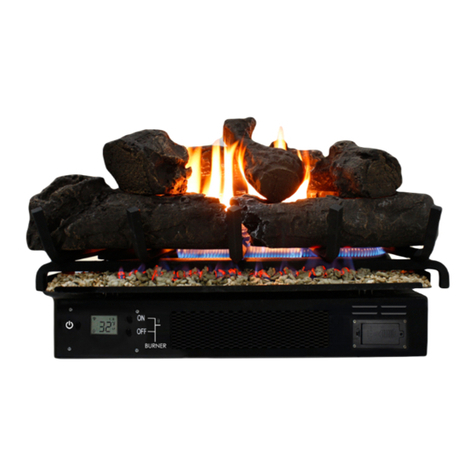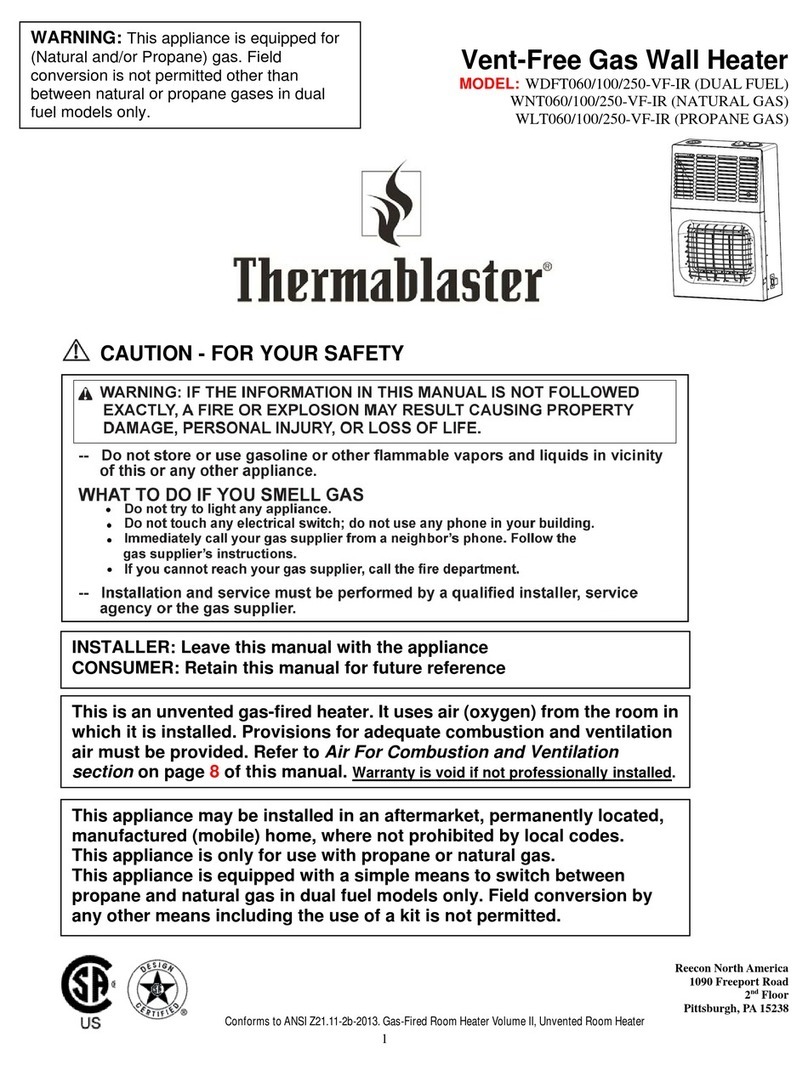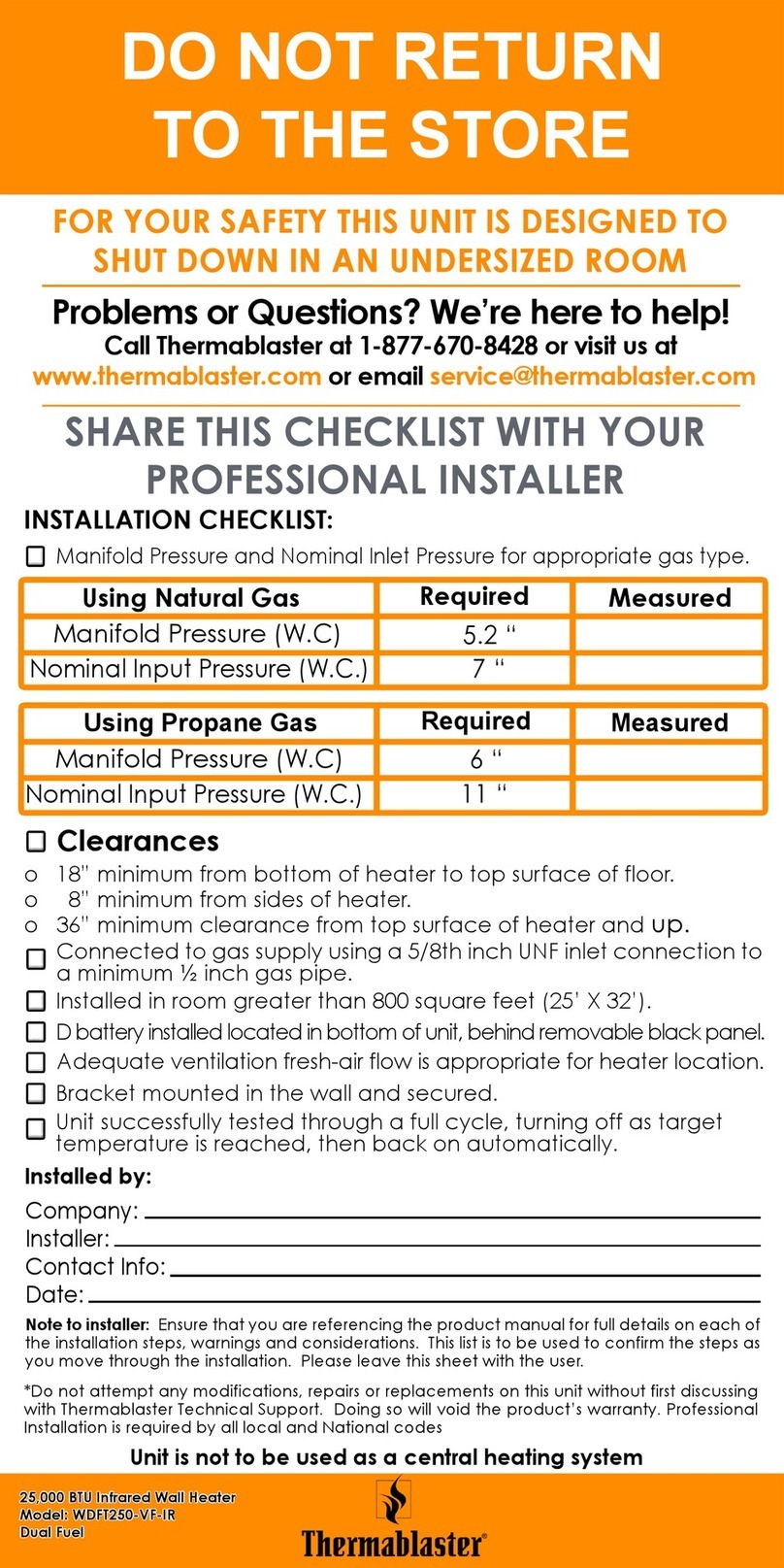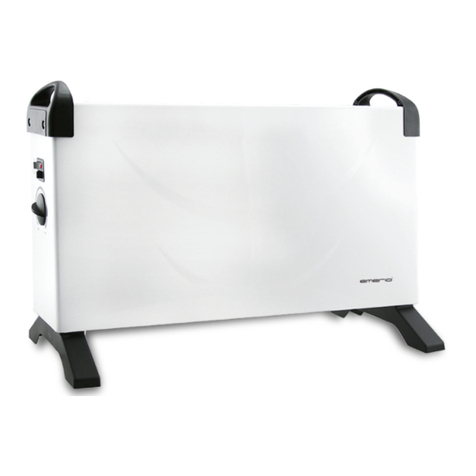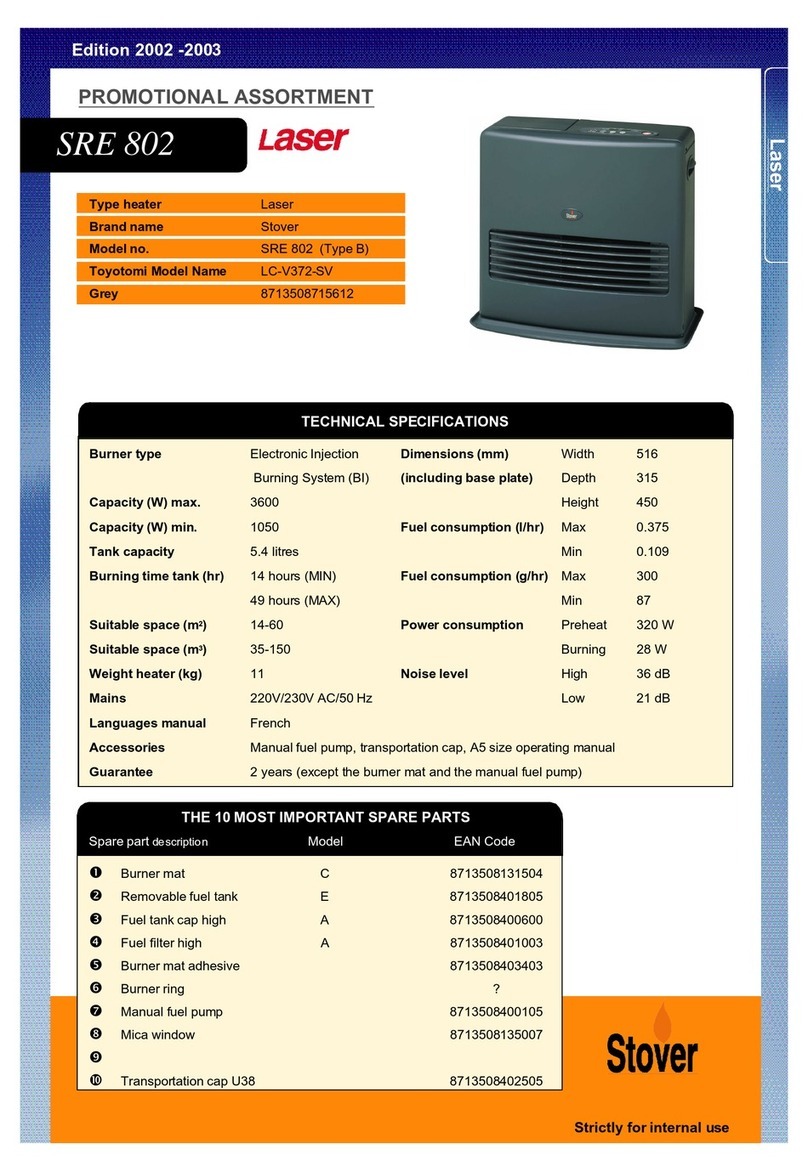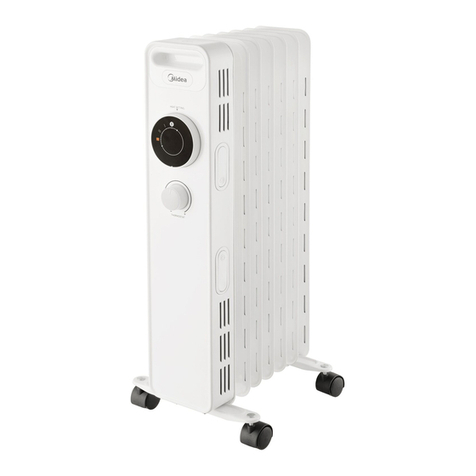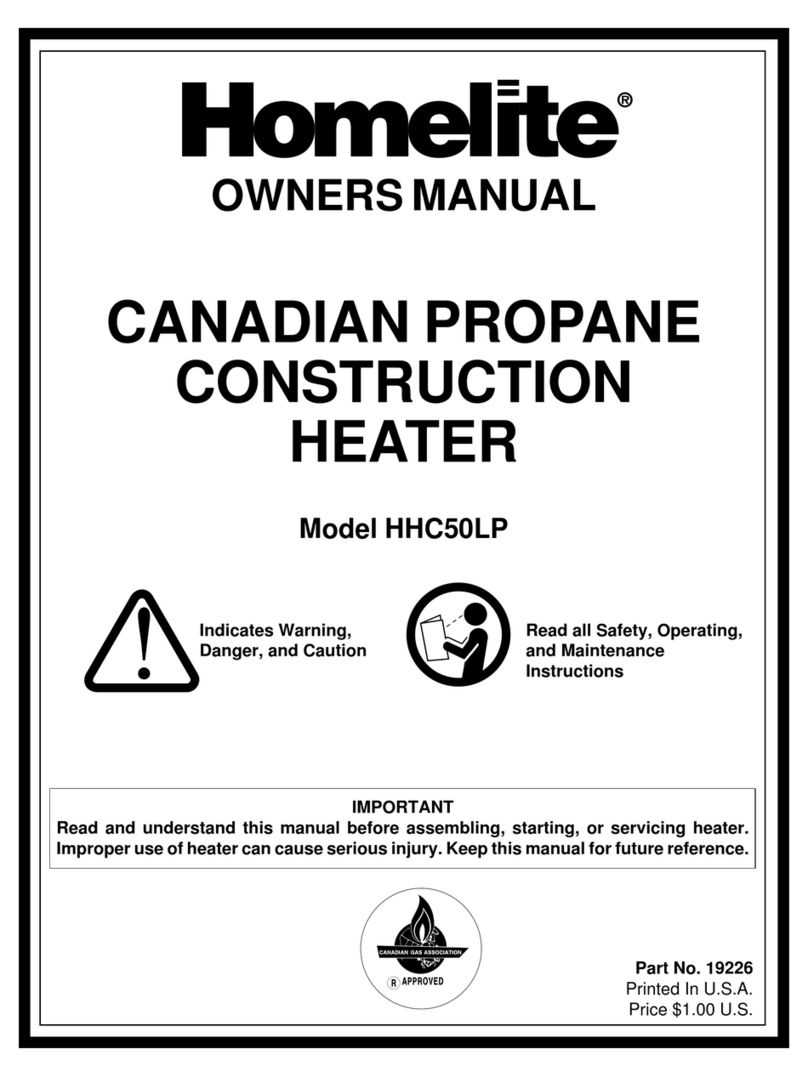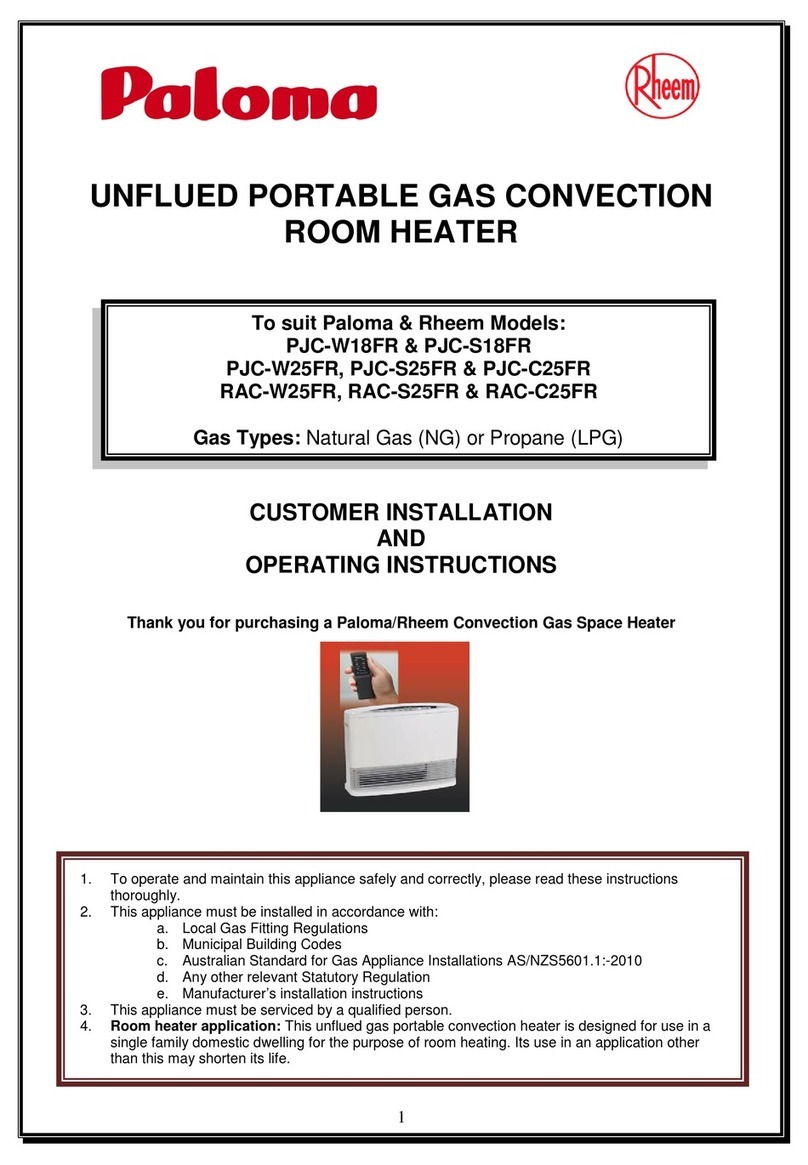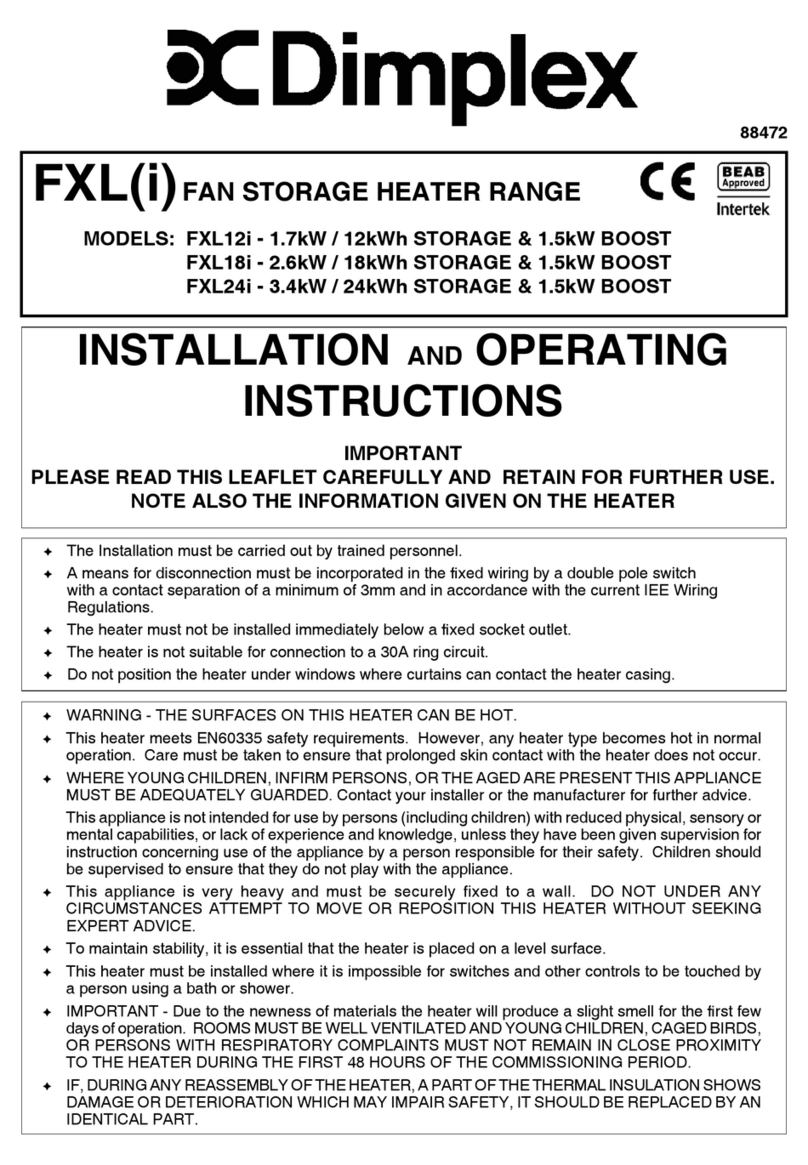Thermablaster WDFT060-VF-IR User manual

- 1 -
Vent-FreeGasWallHeater
MODEL: WDFT060/100/250-VF-IR (DUAL FUEL)
WNT060/100/250-VF-IR (NATURAL GAS)
WLT060/100/250-VF-IR (PROPANE GAS)
CAUTION - FOR YOUR SAFETY
Reecon North America
1090 Freeport Road
2nd Floor
Pittsburgh,PA15238
ConformstoANSZ21.11-2-2013.Gas-FiredRoomHeaterVolumeII,UnventedRoomHeater
This is an unvented gas-fired heater. It uses air (oxygen) from the room in
which it is installed. Provisions for adequate combustion and ventilation
air must be provided. Refer to Air For Combustion and Ventilation
section on page 8 of this manual. Warranty is void if not professionally installed.
INSTALLER: Leave this manual with the appliance
CONSUMER: Retain this manual for future reference
This appliance may be installed in an aftermarket, permanently located,
manufactured (mobile) home, where not prohibited by local codes.
This appliance is only for use with propane or natural gas.
This appliance is equipped with a simple means to switch between
propane and natural gas in dual fuel models only. Field conversion by
any other means including the use of a kit is not permitted.
WARNING: This appliance is equipped for
(Natural and/or Propane) gas. Field
conversion is not permitted other than
between natural or propane gases in dual
fuel models only.

- 2 -
PRODUCT SPECIFICATIONS
1)For Dual Fuel
2)For Natural Gas
Model WDFT060-VF-IR WDFT100-VF-IR WDFT250-VF-IR
Input Rating (Btu/hr) 6000 10000 25000
Gas type Using natural gas Using natural gas Using natural gas
Manifold Pressure (W.C.) 5.2” 5.2” 5.2”
Nominal Input Pressure (W.C.) 7” 7” 7”
Gas type Using propane gas Using propane gas Using propane gas
Manifold Pressure (W.C.) 6” 6” 6”
Nominal Input Pressure (W.C.) 11” 11” 11”
Ignition Electric Pulse Electric Pulse Electric Pulse
Package Dimension
inches (H×W×D)
15.7×7.5×25.6 18.1×7.5×28.7 30.25”×11.00”×28.75”
Model WNT060-VF-IR WNT100-VF-IR WNT250-VF-IR
Input Rating (Btu/hr) 6000 10000 25000
Gas type natural gas natural gas natural gas
Manifold Pressure (W.C.) 4” 4” 4”
Nominal Inlet Pressure (W.C.) 7” 7” 7”
Ignition Electric Pulse Electric Pulse Electric Pulse
Package Dimension
inches(H×W×D)
15.7×7.5×25.6 18.1×7.5×28.7 30.25”×11.00”×28.75”

- 3 -
3) For Propane Gas
Important Note:
1) An unvented room heater having an input rating of more than 10,000 Btu/hr
(2,931 W) shall not be installed in a bedroom or bathroom;
2) An unvented room heater having an input rating of more than 6000 Btu/hr
(1,758 W) shall not be installed in a bathroom.
Model WLT060-VF-IR WLT100-VF-IR WLT250-VF-IR
Input Rating (Btu/hr) 6000 10000 25000
Gas type LP LP LP
Manifold Pressure (W.C.) 10” 10” 10”
Nominal Inlet pressure (W.C.) 11” 11” 11”
Ignition Electric Pulse Electric Pulse Electric Pulse
Package Dimension inches
(HxWxD)
15.7×7.5×25.6 18.1×7.5×28.7 30.25”×11.00”×28.75”

- 4 -
1. IMPORTANT SAFETY INFORMATION
IMPORTANT: Read this owner’s manual carefully and completely before trying to assemble, operate, or
service this heater. Improper use of this heater can cause serious injury or death from burns, fire,
explosion, electrical shock, and carbon monoxide poisoning. Only a qualified installer, service agent, or
local gas supplier may install and service this product.
WARNING: Do not store or use gasoline or other flammable vapors and liquids in the vicinity of
this or any other appliance.
CARBON MONOXIDE POISONING: Early signs of carbon monoxide poisoning resemble the flu with
headache, dizziness and/or nausea. If you have these signs, heater may not be working properly. Get
fresh air at once! Have heater serviced. Some people - pregnant women, persons with heart or lung
disease, anemia, those under the influence of alcohol, those at high altitude - are more affected by
carbon monoxide than others.
Natural and Propane /LP Gas: Natural and Propane/LP gas are odorless. An odor-producing agent is
added to the gas. The odor helps you detect a gas leak. However, the odor added to the gas can fade.
Gas may be present even though no odor exists.
WARNING: Any change to this heater or its controls can be dangerous.
WARNING: Do not use any accessories not approved for use with this heater.
WARNING: Carefully supervise young children when they are in the room with the heater.
WARNING: Make sure grill guard is in place before running heater.
WARNING: Keep the appliance area clear and free from combustible materials, gasoline, and other
flammable vapors and liquids.
WARNING: Due to high temperatures, the appliance should be located out of traffic and away from
furniture and draperies.
WARNING: Heater becomes very hot when running. Keep children and adults away from hot
surfaces to avoid burns or clothing ignition. Heater will remain hot for a time after shutoff. Allow
surfaces to cool before touching.
WARNING: Do not place clothing or other flammable material on or near the appliance. Never place
any objects in the heater.
WARNING: Failure to keep the primary air opening(s) of the burner(s) clean may result in sooting
and property damage.
WARNING: Do not allow fans to blow directly towards the heater. Avoid any drafts that alter burner
flame patterns.
WARNING: Do not use a blower insert, heat exchanger insert or other accessory not approved for
use with this heater.

- 5 -
WARNING: Failure to position the parts in accordance with these diagrams or failure use only parts
specifically approved with this heater may result in property damage or personal injury.
CAUTION: Two gas line installations at the same time are prohibited. The ignition button on the dual fuel
models shall not be depressed while the heater is in operation.
1. This heater shall not be installed in a room or space unless the required volume of indoor combustion
air is provided by the method described in the National Fuel Gas Code, ANSI Z223.1/NFPA 54, the
International Fuel Gas Code, or applicable local codes.
2. Do not place Propane/LP supply tank(s) inside any structure. Propane/LP supply tank(s) must be
placed outdoors.
3. This heater shall not be installed in the place which the strong wind would shut down the appliance.
4. This heater needs fresh air ventilation to run properly. This heater has an Oxygen Depletion Sensing
(ODS) safety shutoff system. The ODS shuts down the heater if not enough fresh air is available. See
Air for Combustion and Ventilation, pages 8 through 11. If heater keeps shutting off, see
troubleshooting.
5. Keep all air openings in front and bottom of heater clear and free of debris. This will ensure enough air
for proper combustion.
6. If heater shuts off, do not relight until you have provided fresh air from outside. If heater keeps shutting
off, have it serviced.
7. Do not run heater where flammable liquids or vapors are used or stored under dusty conditions.
8. Before using furniture polish, wax, carpet cleaner, or similar products, turn heater off. If heated, the
vapors from these products may create a white powder residue within burner box or on adjacent walls
or furniture.
9. Always run heater with control knob at PILOT/IGN, LOW or HIGH locked positions. Never set control
knob between locked positions, otherwise poor combustion and higher levels of carbon monoxide
may be resulted.
10. Do not use this room heater if any part has been under water. Immediately call a qualified service
technician to inspect the room heater and to replace any part of the control system and any gas
control which has been under water.
11. Turn off and let heater cool down before servicing. Only a qualified service person should service and
repair heater.
12. Periodic visual check of pilot and burner flame, with pictorial sketches or drawings.
13. The appliance must be isolated from the gas supply piping system by closing its equipment shut-off
valve during any pressure testing of the gas supply piping system at test pressures equal to or less
than 1/2 psi (3.5 kPa).

- 6 -
QUALIFIED INSTALLING AGENCY
Only a qualified agency should install and replace gas piping, gas utilization equipment or
accessories, repair and service the heater. The term “qualified agency” means any individual, firm,
corporation, or company that either in person or through a representative is engaged in and is
responsible for:
a.) Installing, testing, or replacing gas piping or
b.) Connecting, installing, testing, repairing, or servicing equipment; that is experienced in such work; that
is familiar with all precautions required; and that has complied with all the requirement of the authority
having jurisdiction.
2 PRODUCT FEATURES
SAFETY PILOT
This heater has a pilot with an Oxygen Depletion Sensing (ODS) safety shutoff system. The ODS/pilot
shuts off the heater if there is not enough fresh air.
PULSE IGNITION SYSTEM
This heater is equipped with a battery powered electric pulse igniting system. No AC power supply
required. Battery should be periodically checked and replaced accordingly. Use a “D” size (IEC R20 or
LR20) 1.5 V battery only.
GAS OPTIONS CAPABLE (Dual Fuel Models Only) (Models that start with WDFT)
If you have the dual fuel model, your heater is equipped to operate on either Propane or Natural gas. The
heater can identify gas source automatically without any changes. During first use please let your
qualified installer to install and start the heater following the instructions and the markings on the heater.
THERMOSTATIC CONTROL
These heaters have a control valve with a thermostat sensing bulb. This results in the greatest heater
comfort and may result in lower gas bills.
LOCAL CODES
Install and use heater with care. Follow all local codes. In the absence of local codes, use the latest
edition of The National Fuel Gas Code, ANSI Z223.1/ NFPA 54.

- 7 -
3. Preparing for installation
Before beginning assembly or operation of the product, make sure all parts are present. Compare parts
with package contents list and diagram above. If any part is missing or damaged, do not attempt to
assemble, install or operate the product. Contact customer service for replacement parts.
Before installing heater, make sure you have the items listed below:
Figure 1 - Vent-Free Gas Heater Infrared
UNPACKING
1. Remove heater from carton.
2. Remove all protective packaging applied to heater for shipping
3. Check heater for any shipping damage. If heater is damaged, promptly inform dealer where you bought
heater.
4. Remove thread protective cup on the gas inlet pipe underneath the heater.
5. Install a D size (IEC R20 or LR20) 1.5 V battery (maybe not available in the packing depends on your
dealer). Be sure battery has full capacity and must be removed if the heater is not in use for an
extended period.
Fig 2 - Heater Bottom
Control knob
Plaque plates
Grill
Igniter knob Thermostat knob I
g
niter knob
WDFT/WLT/WNT250-VF-IR
WDFT/WLT/WNT60-VF-IR
WDFT/WLT/WNT100-VF-IR
Battery Pac
k
Thread
protective
cap

- 8 -
4. WATER VAPOR: A BY-PRODUCT OF UNVENTED ROOM HEATERS
Water vapor is a by-product of gas combustion. An unvented room heater produces approximately one (1)
ounce (30 ml) of water for every 1,000 BTUs (0.3 KWs) of gas input per hour. Unvented room heaters are
recommended as supplemental heat (a room) rather than a primary heat source (an entire house). In
most supplemental heat applications, the water vapor does not create a problem. In most applications,
the water vapor enhances the low humidity atmosphere experienced during cold weather. The following
steps will help ensure that water vapor does not become a problem.
1. Be sure the heater is sized properly for the application, including ample combustion air and circulation
air.
2. If high humidity is experienced, a dehumidifier may be used to help lower the water vapor content of
he air.
3. Do not use an unvented room heater as the primary heat source
5. AIR FOR COMBUSTION AND VENTILATION
WARNING: This heater shall not be installed in a confined space or unusually tight construction
unless provisions are provided for adequate combustion and ventilation air. Read the following
instructions to ensure proper fresh air for this and other fuel-burning appliances in your home.
Providing Adequate Ventilation
This heater shall not be installed in a room or space unless the required volume of indoor combustion air
is provided by the method described in the NATIONAL FUEL GAS CODE, ANSI Z223.1/NFPA 54, the
INTERNATIONAL FUEL GAS CODE, or applicable local codes. The following are excerpts from National
Fuel Gas Code, ANSI Z223.1/ NFPA 54. Air for Combustion and Ventilation. All spaces in homes fall into
one of the three following ventilation classifications:
1. Unusually Tight Construction
2. Unconfined Space
3. Confined Space
The information on the followed pages will help you classify your space and provide adequate ventilation.
Confined and Unconfined Space
The National Fuel Gas Code, ANSI Z223 .1/NFPA 54 defines a confined space as a space whose volume
is less than 50 cu. ft. per 1,000 BTU/hr (4.8 m3per kw) of the aggregate input rating of all appliances
installed in that space and an unconfined space as a space whose volume is not less than 50 cubic feet
per 1,000 BTU/hr (4.8 m3per kw) of the aggregate input rating of all appliances installed in that space.
Rooms connecting directly with the space in which the appliances are installed, through openings not
furnished with doors, are considered a part of the unconfined space.
This heater shall not be installed in a confined space or unusually tight construction unless provisions are
provided for adequate combustion and ventilation air. Adjoining rooms are connecting only if there are
odorless passageways or ventilation grills between them.

- 9 -
Unusually Tight Construction
The air that leaks around doors and windows may provide enough fresh air for combustion and ventilation.
However, in buildings of unusually tight construction, you must provide additional fresh air. Unusually
tight construction is defined as construction where:
a) Walls and ceilings exposed to the outside atmosphere have a continuous water vapor retarder with a
rating of one perm (6×10-11kg per pa-sec-m2) or less with openings gasket or sealed and
b) Weather stripping has been added on openable windows and on doors and
c) Caulking or sealants are applied to areas such as joints around window and door frames, between sole
plates and floors, between wall ceiling joints, between wall panels, at penetrations for plumbing,
electrical, and gas lines, and at other openings.
If your home meets all of the three criteria above, you must provide additional fresh air. See “Ventilation
Air From Outdoors”. If your home does not meet all of the three criteria above, proceed to “Determining
Fresh-Air Flow For Heater Location”.
6. DETERMINING FRESH-AIR FLOW FOR HEATER LOCATION
Using this worksheet to determine if you have a confined or unconfined space. Space: Includes the room
in which you will install heater plus any adjoining rooms with doorless passageways or ventilation grills
between the rooms.
1. Determine the volume of the space Length × Width × Height = cu. ft. (volume of space)
Example: Space size 20 ft. (length) × 16 ft. (width)×8 ft. (ceiling height) =2560 cu. ft. (volume of space)
If additional ventilation to adjoining room is supplied with grills or openings, add the volume of these
rooms to the total volume of the space.
2. Divide the space volume by 50 cubic feet to determine the maximum BTU/hr the space can support.
(volume of space) ÷ 50 cu. ft. =(Maximum BTU/hr the space can support)
3. Add the BTU/hr of all fuel burning appliances in the space.
Vent-free heater BTU/hr
Gas water heater* BTU/hr
Gasfurnace BTU/hr
Vented gas heater BTU/hr
Gas heater logs BTU/hr
Other gas appliances* + BTU/hr
Total= BTU/hr
Example:
Gas water heater 30,000 BTU/hr
Vent-free heater + 26,000 BTU/hr
Total = 56,000 BTU/hr
*Do not include direct-vent gas appliances. Direct-vent draws combustion air from the outdoors and vents to the outdoors

- 10 -
4. Compare the maximum BTU/hr the space can support with the actual amount of BTU/hr used
BTU/hr (maximum the space can support)
BTU/hr (actual amount of BTU/hr used)
Example: 51,200 BTU/hr (maximum the space can support)
56,000 BTU/hr (actual amount of BTU/hr used)
The space in the above example is a confined space because the actual BTU/hr used is more than the
maximum BTU/hr the space can support.
You must provide additional fresh air. Your options are as follows:
Rework worksheet, adding the space of an adjoining room. If the extra space provides an unconfined
space,
a) Remove door to adjoining room or add ventilation grills between rooms. See “Ventilation Air From
Inside Building ” on next page.
b) Vent room directly to the outdoors. See “Ventilation Air From Outdoors ” on next page.
c) Install a lower BTU/hr heater if lower BTU/hr size makes room unconfined. If the actual BTU/hr used is
less than the maximum BTU/hr the space can support, the space is an unconfined space. You will need
no additional fresh air ventilation.
WARNING: If the area in which the heater may be operated is smaller than that defined as an
unconfined space or if the building is of unusually tight
construction, provide adequate combustion and ventilation air by
one of the methods described in the National Fuel Gas Code, ANSI
Z223.1/NFPA 54. Air for Combustion and Ventilation, or applicable
local codes.
WARNING: If the area in which the heater may be operated
does not meet the required volume for indoor combustion
air, combustion and ventilation air shall be provided by one of the
methods described in the National Fuel Gas Code, ANSI
Z223.1/NFPA 54, the International Fuel Gas Code, or applicable
local codes.
Ventilation Air From lnside Building
This fresh air would come from an adjoining
unconfined space.
When ventilating to an adjoining unconfined
space, you must provide two permanent
openings: one within 12 inches of the ceiling and one within 12 inches of the floor on the wall connecting
the two spaces (see options 1 and 2, Figure 3). You can also remove the door into adjoining room (see
option 3, Figure 3). Follow the National Fuel Gas Code. ANSI Z223.1/NFPA 54, Air for Combustion and
Ventilation for required size of ventilation grills or ducts.
Figure 3 - Ventilation Air from Inside Building
NOTE: Base not included. Not for use in bedrooms or bathrooms.

- 11 -
Ventilation Air From Outdoors
Provide extra fresh air by using ventilation grills or ducts. You
must provide two permanent openings: one within 12 inches
of the ceiling and one within 12 inches of the floor. Connect
these items directly to the outdoors or spaces open to the
outdoors. These spaces include attics and crawl spaces.
Follow the National Fuel Gas Code, ANSI Z223.1/ NFPA 54,
Air for Combustion and Ventilation for required size of
ventilation grills or ducts.
IMPORTANT: Do not provide openings for inlet or
outlet air into attic if attic has a thermostat-controlled
power vent. Heated air entering the attic will activate the power vent. Rework worksheet, adding the
space of the adjoining unconfined space. The combined spaces must have enough fresh air to supply all
appliances in both spaces.
7. INSTALLATION
NOTICE: This heater is intended for use as supplemental
heat. Use this heater along with your primary heating
system. Do not install this heater as your primary heat
source. If you have a central heating system, you may
run system’s circulating blower while using heater. This
will help circulate the heat throughout the house. In the
event of a power outage, you can use this heater as your
primary heat source.
Caution: If you install the heater in a home garage, heater pilot and burner must be
atleast18 inches above the floor. Place heater where moving vehicle will not hit it.
WARNING: A qualified service person must install heater. Follow all local codes.
WARNING: Never install the heater:
in a recreational vehicle
where curtains, furniture, clothing, or other flammable objects are less than 36 inches from the
front, top, or sides of the heater
in high traffic areas
in windy or drafty areas
CAUTION: This heater creates warm air currents. These currents move heat to wall surfaces next
to heater. Installing heater next to vinyl or cloth wall coverings or operating heater where impurities (such
as tobacco smoke, aromatic candles, cleaning fluids, oil or kerosene lamps, etc.) in the air exist, may
cause walls to discolor.
IMPORTANT: Vent-free heaters add moisture to the air. Although this is beneficial, installing
heater in rooms without enough ventilation air may cause mildew to form too much moisture. See Air for
Combustion and Ventilation.
Figure 4 - Ventilation Air from Outdoors
Figure 5 - Mounting clearances from combustibles

- 12 -
Figure
6
-
Mounting holes Location
Check Gas Type
Be sure your gas supply is right for your heater. Otherwise, call dealer where you bought the heater from
for proper type heater.
Clearances to Combustibles
Carefully follow the instructions below. This heater is a freestanding unit
designed to be mounted on a wall.
WARNING: Maintain the minimum clearances shown in
Figure 4. If you can, provide greater
clearances from floor, ceiling, and joining wall.
LOCATING HEATER
This heater is designed to be mounted on a wall. For convenience and
efficiency, install heater:
1) where there is easy access for operation, inspection, and service.
2) In the coldest part of room.
MOUNTING HEATER TO WALL
1. Mounting the Bracket
Mounting the attached bracket with folding anchor on desired location
2. Hang the heater on the bracket。
8 CONNECTING TO GAS SUPPLY
WARNING: A qualified service technician must connect heater to
gas supply. Follow the heater specification and all local codes. Wrong
gas supply may result improper operation, or damage on your heater, property or/and personal body.
WARNING: This appliance requires a 3/8-inch NPT (National Pipe Thread) inlet connection to the
pressure regulator.
WARNING: Never connect heater to private (non-utility) gas wells. This gas is commonly known as
wellhead gas.
WARNING: Do not over-tighten gas connections.
CAUTION: Use only new, black iron or steel pipe. Internally tinned copper tubing may be used in
certain areas. Check your local codes. Use pipe of 1/2-in. diameter or greater to allow proper gas
volume to heater. If pipe is too small, undue loss of pressure will occur.
Figure 7 Mounting on wall

- 13 -
NATURAL GAS MODELS:
CAUTION: Check your gas line pressure before connecting heater to gas line. Gas line pressure
must be no greater than 8 inches of water column. If gas line pressure is higher, damage on
appliance regulator could occur.
PROPANE MODELS:
CAUTION: Never connect heater directly to the gas supply.
This heater requires an external regulator (not supplied).
Install the external regulator between the heater and gas supply.
CAUTION: Avoid damage to regulator. Hold gas regulator
with wrench when connecting into gas piping and/or fittings.
CAUTION: Use pipe joint sealant that is resistant to gas
(Propane or Natural Gas).
IMPORTANT: Install an equipment shutoff valve in an accessible location where the gas pipe goes
indoors. The equipment shutoff valve is for turning on or shutting off the gas to the appliance. Apply pipe
joint sealant lightly to male threads. This will prevent excess sealant from going into pipe. Excess sealant
in pipe could result in clogged heater valves. The installer must supply an external regulator with nominal
out let pressure of 11” water column and sufficient flow rates. Install external regulator with the vent
pointing down as shown in Figure 8. Pointing the vent down protects it from freezing rain or sleet. If
flexible gas hose is applied, it should meet the requirements of ANSI/UL569 Standard for Pigtail and
Flexible Hose Connection for LP-Gas. Improper regulator and/or gas hose assembly may occur damage
on your heater, property or/and personal body.
CAUTION: Two gas lines installation at the same time is forbidden. Do not the open cover while the
heater is running.
CAUTION: To avoid gas leakage at the inlet of appliance regulator, a qualified installer or service
technician must use steel or metal hex plug with sealant.
For changing from propane to natural gas supply (WDFT dual fuel models only):
1) Your heater is equipped with an unique automatic gas source detection and configuration system
allowing to perform both LP gas and nature gas without any manual conversion.
2) Anyway only a qualified installer or service technician can perform gas version from between LP
gas and natural gas supply because of the connection and installation external the heater.
CHECKING GAS CONNECTIONS
WARNING: Test all gas piping and connections for leaks after installing or servicing. Correct all
leaks at once.
WARNING: Never use an open flame to check for a leak. Apply a mixture of liquid soap and water to
all joints. If bubbles form, there is a leak. Correct all leaks at once.
Propane/LP
su
pp
l
y
tan
k
External regulator
Figure 8 - External Regulator with Vent Pointing Down

- 14 -
Pressure Testing Gas Supply Piping System
Test Pressures In Excess Of 1/2 PSIG (3.5kPa)
1. Disconnect heater with its appliance main gas valve (control valve) and equipment shutoff valve from
gas supply piping system. Pressures in excess of 1/2 PSIG will damage heater regulator.
2. Cap off open end of gas pipe where equipment shutoff valve was connected.
3. Pressurize supply piping system by either using compressed air or opening gas supply valve.
4. Check all joints of gas supply piping system. Apply mixture of liquid soap and water to gas joints. If
bubbles form, there may be a leak.
5. Correct all leaks at once.
6. Reconnect heater and equipment shutoff valve to gas supply. Check reconnected fittings for leaks.
Test Pressures Equal To or Less Than 1/2 PSIG (3.5 kPa)
1. Close equipment shutoff valve
2. Pressurize supply piping system by either using compressed air or opening natural supply tank valve.
3. Check all joints from gas meter to equipment shutoff valve. Apply mixture of liquid soap and water to
gas joints. If bubbles form, there is a leak.
4. Correct all leaks at once.
Pressure Testing Heater Gas Connections
1. Open equipment shutoff valve.
2. Open gas supply tank valve.
3. Make sure control knob of heater is in the OFF position.
4 Check all joints from equipment shutoff valve to control valve. Apply mixture of liquid soap and water to
gas joints. If bubbles form, there may be a leak.
5. Correct all leaks at once.

- 15 -
9. OPERATION
FOR YOUR SAFETY READ BEFORE LIGHTING
WARNING: If you do not follow these instructions exactly, a fire or explosion may result causing
property damage, personal injury or loss of life.
1) When lighting the pilot, follow these instructions exactly.
2) BEFORE LIGHTING, smell all around the appliance area for gas. Be sure to smell next to the floor
because some gas is heavier than air and will settle on the floor.
3) Use only your hand to push in or turn the gas control knob. Never use tools. If the knob will not push in
or turn by hand, don’t try to repair it, call a qualified service technician or gas supplier. Forced or
attempted repair may result in a fire or explosion.
4) Do not use this appliance if any part has been under water. Immediately call a qualified service
technician to inspect the appliance and to replace any part of the control system and any gas control
which has been under water.
WHAT TO DO IF YOU SMELL GAS
Open the window or door immediately.
Do not try to light any appliance.
Do not touch any electric switch, do not use any phone in your building.
Immediately call your gas supplier from a neighbor’s phone. Follow the gas supplier’s instructions.
If you cannot reach your gas supplier, call the fire department.
Lighting INSTRUCTIONS
Before Lighting
1. Make sure the heater is properly installed and connected. Open the external safety shut off valve (not
part of the heater) on gas inlet line to the heater.
2. Wait five (5) minutes to clear out air inside gas lines. Smell if there is any leakage.
IMPORTANT: If you smell any gas, don’t try to light any appliances, do not touch electrical
switches or use any phone in the building. Shut off the valve on gas inlet line immediately and
contact gas supplier from a neighbor’s phone. Follow gas supplier’s instructions. If you can’t
reach the gas supplier, call the fire department. Only when you make sure there is no gas leakage,
go to the next step.

- 16 -
Heater Models: WDFT060/100-VF-IR
WNT060/100-VF-IR
WLT060/100-VF-IR
Figure - 9
1. Turn the thermostat Control button to full position, turn the appliance gas valve ( -PILOT-OFF)
button to the “Pilot” position.
2. Push down the appliance gas valve and keep it depressed for several minutes, so that all the air in the
manifests are cleared out.
3. Keep the gas valve button depressed while pushing down the igniter button thoroughly until ignition
can be heard. Both buttons must be remain depressed for at least 15 seconds until the pilot is lit up
and the sensor has heated up enough.
4. Release both buttons. If pilot goes out, repeat step 3 and step 4.
5. When the pilot flame stays stable, slightly push the gas valve button down and turn from the PILOT
position to the on position ( ) QUICKLY without stopping in between positions. Heater will then
operate normally. Now you can turn the thermostat control button to the position as your desired
temperature (approximately 40 OF to 80 OF from the range min. to max.)
To stop the heater shut off the valve in gas inlet line (not included in delivery scope) first, then turn the
appliance gas valve to “OFF” position.
Heater Models: WDFT250-VF-IR
WNT250-VF-IR
WLT250-VF-IR
Figure - 10
Igniter button
Gas valve
b
utton
Temperature control button
Igniter button
Combination
control
b
utton

- 17 -
1. Turn the appliance combination control valve button to the “Pilot” position. This should line up with
arrow on the top of the heater.
2. Push down the appliance combination control valve button and keep it depressed for several minutes,
so that all the air in the manifests are cleared out.
3. Keep the combination control valve button depressed and while pushing down the igniter button
thoroughly until ignition can be heard. Both buttons should remain depressed for at least 15 seconds
until the pilot is lit up and the sensor is heated up enough.
4. Release both buttons. If pilot goes out, repeat step 3 and step 4.
5. When the pilot flame is stable, slightly push the gas valve button down and turn to the “6” position
QUICKLY without stopping in between. Heater will then operate normally. Now you can turn the
control button to the position as your desired temperature (approximately 50 OF to 100 OF from the
position 1 to 5).
To stop the heater shut off the valve in gas inlet line (not included in delivery scope) first, then turn the
appliance gas valve to “OFF” position.
INSPECTING BURNER
Check pilot flame pattern and burner flame pattern often.
Fig – 11 Fig - 12
PILOT FLAME PATTERN
To ensure quick ignition and efficient ODS function, your heater is uniquely equipped with a supplemental
pilot burner as shown in Fig. 11. The normal ODS pilot flame should have a correct pattern as shown in
Fig. 12 in normal operation with exception during ignition stage.
WARNING:If yellow tipping occurs, your heater could produce increased levels of carbon monoxide.
If burner flame pattern shows yellow tipping, follow instructions at bottom of this page.
Notice: Do not confuse orange flames with yellow tipping. Dirt or other fine particles enter the heater and
burn causing brief patches of orange flame.
LP ODS Pilot Burner Supplemental Pilot burner NAT ODS Pilot Burner

- 18 -
10. CARE AND MAINTENANCE
WARNING: Turn off heater and let cool before servicing
CAUTION: You must keep control areas, burner, and circulating air passageways of the heater clean.
Inspect these areas of heater before each use. Have heater inspected yearly by a qualified service
technician. Heater may need more frequent cleaning due to excessive lint from carpeting, bedding
material, pet hair, etc.
ODS/PILOT AND BURNER
Use a vacuum cleaner, pressurized air, or a small, soft bristled brush to clean.
CLEANING BURNER PILOT AIR INLET HOLE
We recommend that you clean the unit every 2,500 hours of operation or every three months. We also
recommend that you keep the burner tube and pilot assembly clean and free of dust and dirt. To clean
these parts we recommend using compressed air no greater than 30 PSl. Your local computer store,
hardware store, or home center may carry compressed air in a can. You can use a vacuum cleaner in the
blow position. If using compressed air in a can, please follow the directions on the can. If you don’t follow
directions on the can, you could damage the pilot assembly.
1. Shut off the unit, including the pilot. Allow the unit to cool for at least thirty minutes.
2. Inspect burner and pilot for dust and dirt.
3. Blow air through the ports/slots and holes in the burner. Also clean the pilot assembly. A yellow tip on
the pilot flame indicates dust and dirt in the pilot assembly. There is a small pilot air inlet hole about two
inches from where the pilot flame comes out of the pilot assembly (see Figure13. With the unit off,
lightly blow air through the air inlet hole. You may blow through a drinking straw if compressed air is not
Available.
CABINET
Air Passageways
Use a vacuum cleaner or pressurized air to clean.
Exterior
Use a soft cloth dampened with a mild soap and water mixture.
Wipe the cabinet to remove dust
1) Use a soft cloth dampened with a mild soap and water mixture.
2) Wipe the cabinet to remove dust.

- 19 -
11. TROUBLE SHOOTING
WARNING: If you smell gas:
1) Open the window and door immediately.
2) Shut off gas supply.
3) Do not try to light any appliance.
4) Do not touch any electrical switch; do not use any phone in your building.
5) Immediately call your gas supplier from a neighbor’s phone. Follow the gas supplier’s instructions.
6) If you cannot reach your gas supplier, call the fire department.
IMPORTANT: Operating heater where impurities in air exist may create odors. Cleaning supplies, paint,
paint remover, cigarette smoke, cements and glues, new carpet or textiles, etc., create fumes. These
fumes may mix with combustion air and create odors.
WARNING: Only a qualified service technician should service and repair heater.
CAUTION: Never use a wire, needle, or similar object to clean ODS/pilot. This can damage ODS/ pilot
unit. Note: All troubleshooting items are listed in order of operation.
No. PROBLEM POSSIBLE CAUSE REMEDY
1 When igniter knob is pressed in
there is no spark at ODS/pilot.
1. Igniter electrode is positioned
wrongly.
2. Cables between switch, battery
pack, igniter and igniter electrode may
be loose, pinched, wet or broken.
3. Bad igniter
4. No battery or battery used out.
1. Reposition igniter electrode..
2. Secure or replace cables between
switch, battery pack, igniter and igniter
electrode.
3. Replace igniter.
4. Install or replace battery.
2 When igniter knob is
pressed in there is a spark
at ODS/pilot but no ignition.
1. Gas supply is turned off or
equipment shutoff valve is closed.
2. Control knob not fully pressed in
while pressing igniter button.
3. Air in gas lines when installed.
4. ODS/pilot is clogged.
5. Control knob not in PILOT position.
6. External shut off valve on gas
supply opened too fast and blocked
appliance regulator in heater
1. Turn on gas supply or open equipment
shutoff valve.
2. Fully press in control knob while
pressing igniter button.
3. Continue holding down control knob.
Repeat igniting operation until air is
removed.
4. Clean ODS/pilot or replace ODS/pilot
assembly.
5. Turn control knob to PILOT position.
6. Close external shut off valve and
re-open slowly.
3 ODS/pilot lights but flame
goes out when control
knob is released.
1. Both control knob and igniter knob
are not fully depressed.
2. Thermocouples are not heated
enough.
3. External shutoff valve of gas supply
is not fully opened.
4. Thermocouple connections are
loose or damaged.
5. Control valve damaged.
1. Press in both knobs fully.
2. After ODS/pilot lights, keep both knobs
depressed for at least 15 seconds.
3. Fully open equipment shutoff valve.
4. Secure or replace thermocouple
connections.
5. Contact customer service.
4 Burner(s) does not light after
ODS/pilot is lit stably
1. Burner orifice is clogged.
2. Burner orifice diameter is too small.
3. Inlet gas pressure is too low.
1. Clean burner orifice or replace burner
orifice.
2. Contact customer service.
3. Contact local gas supplier.
5 Delayed ignition of burner(s).
1. Manifold pressure is too low.
2. Burner orifice is clogged.
3. Burner is not correctly aligned.
1. Contact local gas supplier.
2. Clean or replace burner orifice.
3. Contact customer service

- 20 -
6 Burner backfiring during
combustion.
1. Burner orifice is clogged,
2. Burner is damaged.
3. Burner is not correctly aligned
4. Gas regulator or/and appliance
regulator are defective.
1. Clean burner or replace burner orifice,
2. Contact customer service.
3. Contact customer service.
4. Contact customer service.
7 Yellow flame during burner
combustion. 1. No enough air.
2. Heater bottom blocked
3. Gas regulator is defective.
4. Inlet gas pressure is too low.
1. Check burner for dirt and debris. If
found, clean burner.
2. Clean heater bottom from any flagging
materials,
3. Replace gas regulator.
4. Contact local gas supplier.
8 Slight smoke or odor during initial
operation.
1. Residues from manufacturing
processes.
1. Problem will stop after a few hours of
operation..
9 Heater produces a
whistling noise
when burner is lit.
1. Turning control knob to Hi. position
when burner is cold.
2. Air in gas line.
3. Air passageways on heater are
blocked.
4. Dirty or partially clogged burner
orifice.
1. Turn control knob to LO position and let
warm up for a minute.
2. Operate burner until air is removed from
line. Have gas line checked by local gas
supplier.
3. Observe minimum installation
clearances
4. Clean or replace burner.
10 Heater produces a clicking/
ticking noise just after burner is lit
or shut off.
1. Metal is expanding while heating or
contracting while cooling.
1. This is common with most heaters. If
noise is excessive, contact qualified
service technician.
11 White powder residue forming
within burner box or on adjacent
walls or furniture.
1. When heated, the vapors from
furniture polish, wax, carpet cleaners,
etc., turn into white powder residue.
1. Turn heater off when using furniture
polish, wax, carpet cleaner, or similar
products.
12 Heater produces unwanted
odors.
1. Heater is burning vapors from
paint, hair spray, glues, etc. See
IMPORTANT statement.
2. Gas leak. See Warning Statement
3. Low fuel supply.
1. Ventilate room. Stop using odor causing
products while heater is running.
2. Locate and correct all leaks,
3. Refill supply tank (Propane / LP
models).
13 Heater shuts off in use
(ODS operates).
1. Not enough fresh air is available.
2. Low line pressure.
3. ODS/pilot is partially clogged.
1. Open window and/or door for
ventilation.
2. Contact local gas supplier.
3. Clean ODS/pilot
14 Gas odor during combustion
1. Gas leak. See Warning Statement
2. Control valve is defective.
3. Foreign matters in heater
1. Locate and correct all leaks.
2. Contact customer service.
3. Remove foreign matters
15 Unexpected
moisture/condensation noticed
on windows.
1. Ambient moisture is too high,
2. No enough ventilation 1. Use a dehumidifier,
2. Refer to “Air for combustion and
Ventilation requirements”
Other manuals for WDFT060-VF-IR
1
This manual suits for next models
8
Table of contents
Other Thermablaster Heater manuals
Popular Heater manuals by other brands

BN Thermic
BN Thermic CH2-30L instructions
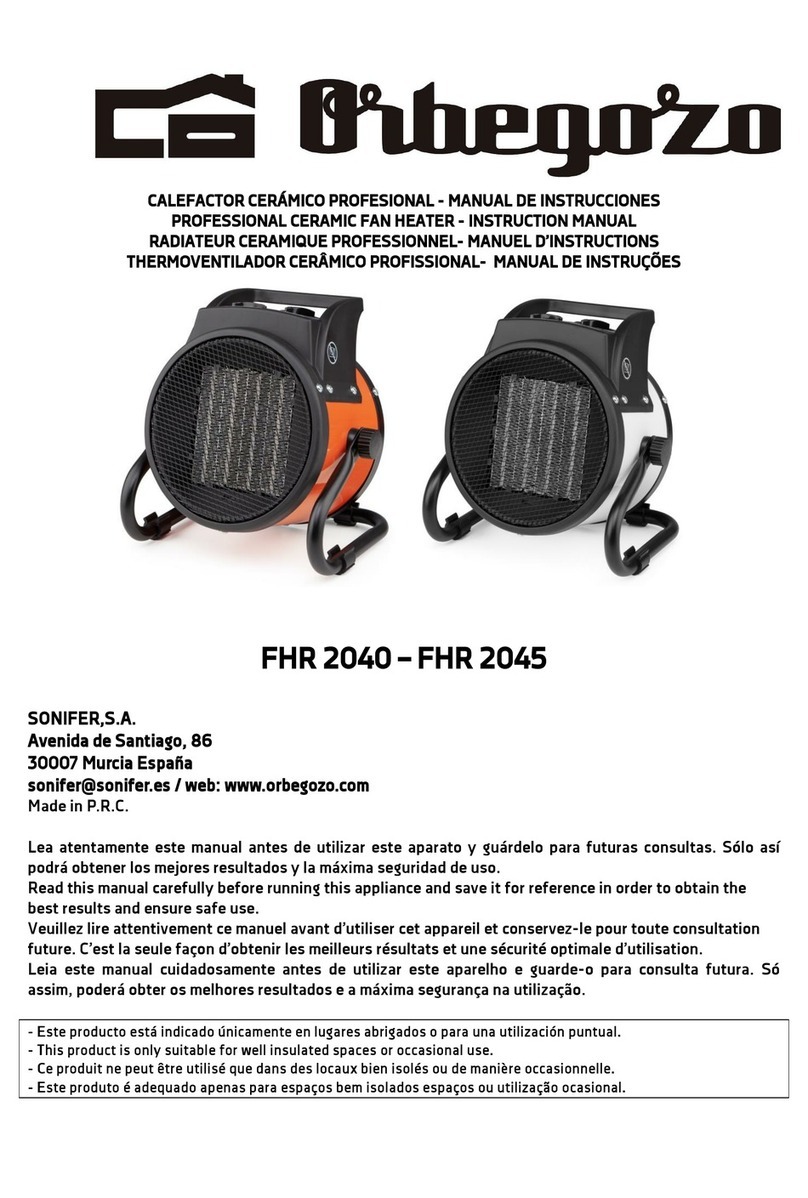
Orbegozo
Orbegozo FHR 2045 instruction manual
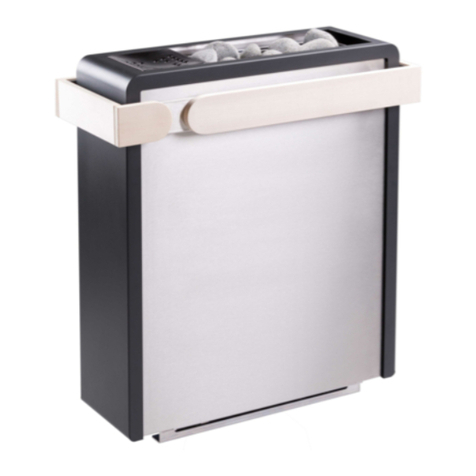
Harvia
Harvia sentiotec Concept R mini combi Instructions for installation and use
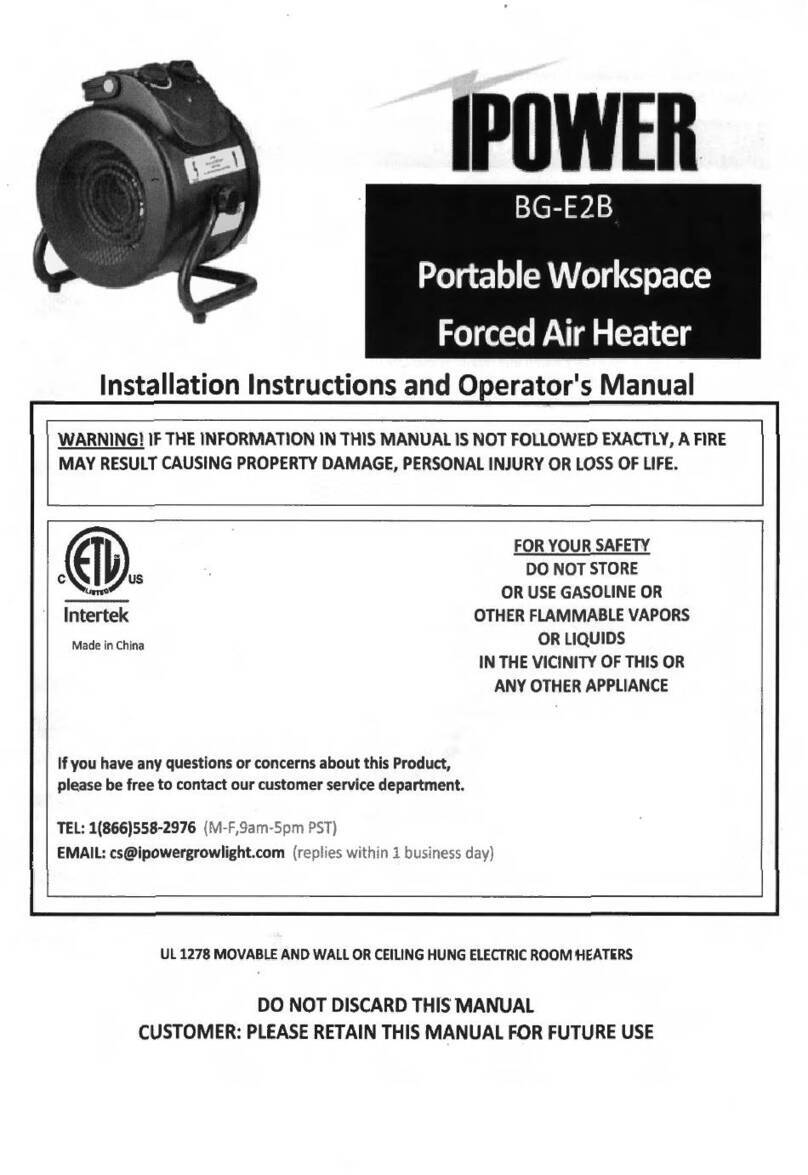
iPower
iPower BG-E2B Installation instructions and operators manual

Heatstore
Heatstore HSP500SSE Installation & Control Guide
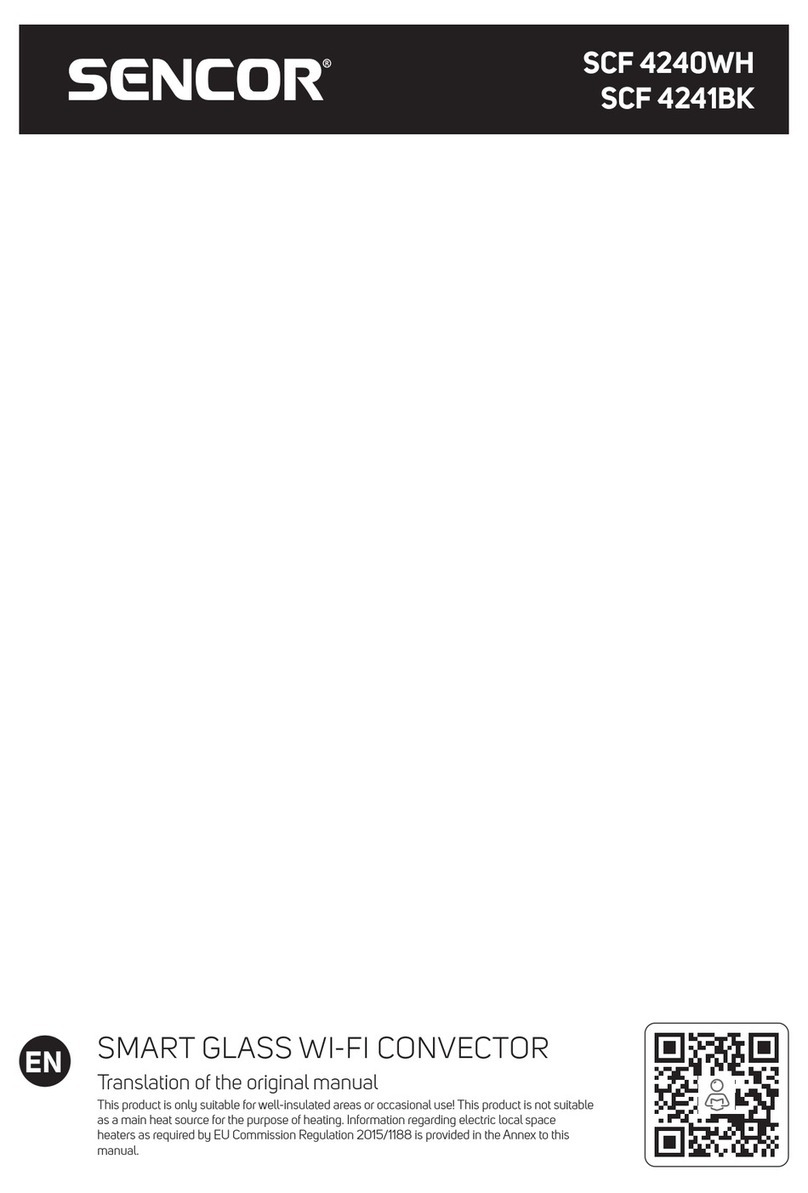
Sencor
Sencor SCF 4240WH Translation of the original manual


